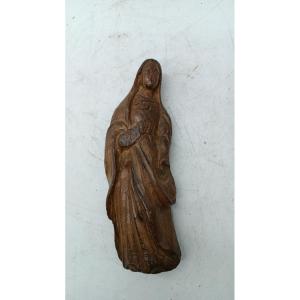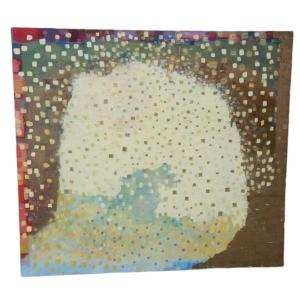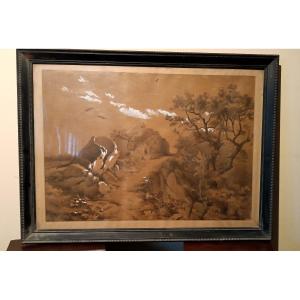Oil on panel on the back it bears the writing "original Dilvo Lotti 1939, restored by Dilvo Lotti in 1978 and the signature has been cancelled" also bears a paper tag - Coming from an elegant residence in San Miniato.
White and gold frame -
size frame 77x57 cm -- work 64 x44 cm
Dilvo Lotti (San Miniato, 27 June 1914 – San Miniato, 22 April 2009) was an Italian painter.
Biography
Dilvo Lotti began painting in 1931 with a box of oil paints given to him by his teacher Francesco Chiappelli, a box which is still preserved today in the house-museum of San Miniato, kept by his wife after his death.
Under the guidance of Chiappelli he attended the Porta Romana Art Institute in Florence where he graduated in 1935 discussing his thesis on Honoré Daumier.
The 1930s were years spent mainly in Florence, where artists and writers usually met in places like "Le Giubbe Rosse" or "l'Antico Fattore". He exchanged letters with figures of Florentine culture: Ardengo Soffici, Giovanni Papini, Baccio Maria Bacci, Nicola Lisi, Pietro Parigi, Francesco Chiappelli, Giorgio La Pira, and some wrote criticisms about him.
In 1936 he participated in the painting competition at the Games of the XI Olympiad
An exponent of European Expressionism, however, he took tradition into account and sought a relationship with sacred art; in 1941 he exhibited at the Gallery of Rome and was invited to participate in the Milan Triennale, the Rome Quadrennial and, in 1942, the Venice Biennale (with a room of sixteen works). In 1947 in his city he founded, together with other friends, the Institute of Popular Drama. In these years he directed the shows Marianna Pineda and They arrived at a city. In 1950 he was invited to the Carnegie Prize in Pittsburgh.
From 1953 to 1985 he dedicated himself to vast fresco and graffiti works in churches and other buildings such as the chapel of the retirement home in Ponsacco, the cathedral of Pontedera, the apse of the church of the Knights of Tau in Altopascio, the church of Gesù Divino Lavoratore al Campaccio in Prato, the Bardi Youth House, the church of Santa Marcella in Rome, the refectory of the Seminary Episcopal of San Miniato, the house of the Mutilated in San Miniato, the Council room of the Cassa di Risparmio in San Miniato.
In 1957 Lotti won the international competition announced by the Pontifical Commission for Sacred Art with the work Gesù Divino Lavoratore, a work located in Assisi.
In 1966 the Diocesan Museum of Sacred Art of San Miniato was inaugurated, thanks to the work and interest of Lotti himself, who became its organizer, in the spaces of the ancient sacristy, adjacent to the Cathedral of Santa Maria Assunta and San Genesio.
In 1968 he was awarded the "Silver Medal for merit in the school of culture and art" by the President of the Republic.
In 1983 he was appointed Corresponding Academician of the Pontifical Insigne Accademia dei Virtuosi al Pantheon.
In 1995, from 10 May to 9 June in Hildesheim, Germany, an anthological exhibition was dedicated to him in the two locations of the Town Hall and the church of San Jacopo.
The dimensions of some works are notable, such as the Barefoot Procession or the Martyrdom of Savonarola. Sometimes he also used the Buon Fresco technique.
He is also the author of various historical and artistic studies, in particular a history of San Miniato.
On 15 July 2006 the exhibition "Dilvo Lotti: a master of European expressionism" was inaugurated in San Miniato.
On 1 April 2008 he was awarded the title of Commander with Plaque of the Order of Saint Gregory the Great by Pope Benedict XVI; the honor was awarded to him by the bishop of San Miniato Fausto Tardelli.
On 20 February 2009 he was awarded the title of Honorary Academician by LABA, Free Academy of Fine Arts of Florence, during the presentation of the first degree thesis on his work, entitled "Dilvo and his women", by the student Lara Cavallini.


















































 Le Magazine de PROANTIC
Le Magazine de PROANTIC TRÉSORS Magazine
TRÉSORS Magazine Rivista Artiquariato
Rivista Artiquariato